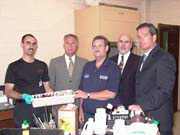Who would have guessed that moving the Secaucus High School science lab was a $4,500 expense? The tab was picked up by the Hudson County Improvement Authority (HCIA), who contracted with Radiac Environmental Services to remove hazardous chemicals that require special disposal in order to open the newly constructed science labs for next year.
“It’s a no brainer,” said Principal Pat Impreveduto. “There are chemicals we know we can’t throw out in the garbage. We thank them for doing it, of course.”
Hazardous household waste consists of chemicals that, while not unsafe for careful handling, might not belong in landfills where normal garbage goes, or may be appropriate for recycling.
HCIA Director Norman Guerra said, “It doesn’t mean that the materials are unsafe, but you just can’t throw them in your normal trash anymore.”
Household hazardous waste includes chemicals like cleaners, paint thinners and used paints, which in the past may have been thrown out with the regular garbage.
“As people become more aware of the environment, such materials are collected, segregated and disposed of. Some are amended [mixed with another chemical] and certain pesticides are incinerated, but none of it is land filled,” said Guerra.
John Tekin, operations manager for Radiac Environmental Services, said that the county’s recycling program aims to keep the public aware of the value of recycling.
“The reason for recycling is to educate the public to remove household hazardous waste from solid waste disposal so it does not end up in the landfills,” said Tekin. “Why put it in landfills when you can treat it and recycle?”
Tekin also said that separating the household hazardous materials protects garbage handlers who might pick up the materials during the course of routine garbage collection.
Different types of treatment
Radiac Environmental collects packages and transports and disposes all household hazardous waste that is brought in by Hudson County residents. They collect twice a year, in the spring and fall, when residents bring in used paint, car batteries, paint thinners or pesticides, for example.
Guerra stresses that the household hazardous waste does not include innately dangerous materials. “It’s not chromium or anything like that,” he said.
Items such as paint thinners and other flammable liquids are recycled through a process called fuel blending. “It’s a form of recycling,” said Tekin. “All these liquids have a burn value, so all these sites charge a fee for blending the materials and selling it off to cement kilns.”
The process involves pumping the waste off and blending it with other fuels. The blending companies sell it for a small fee, but still need to charge the cost of processing it, as with other forms of waste treatment.
Other wastes, such as corrosive materials, are treated and neutralized at waste disposal facilities.
Poisons and pesticides are incinerated at licensed hazardous waste incinerators. Batteries, such as nickel cadmium, silver, or lead acid batteries are recycled, as is motor oil and anti-freeze.
Impreveduto said that the school doesn’t usually require the chemical disposal services because they normally use all the materials they purchase.
However, this year, with the construction of a new science lab and upgrade of the six existing labs, the chemicals needed to be disposed of.
The new lab, along with eight other new classrooms, will be open for use in September, and a new auditorium is expected by 2005
